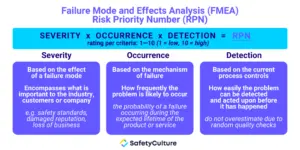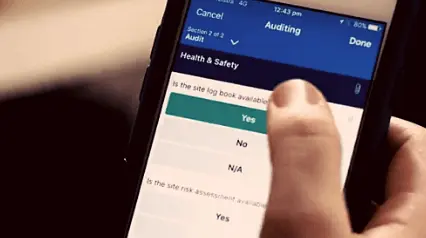What is FMEA?
Failure Mode and Effects Analysis (FMEA) is a proactive method of uncovering potential failures in business processes in order to prevent them from happening or mitigate their effect by finding out where they might occur and determining their impact. FMEA’s systematic approach to identifying and addressing causes of failures can help prevent costly manufacturing issues, improve product quality and service reliability, as well as increase customer satisfaction.
Questions about FMEA
Some of the questions about FMEA are why is it performed and how do you do it? How do you proactively determine which parts of a business process or which steps in a manufacturing assembly line might fail and how will the failure happen? How will one know the impact of the failures and how can those failures be prevented from happening in the first place? What are the types of FMEA? Is there a tool I can use for FMEA? How do you even correctly pronounce FMEA? These are some of the topics about FMEA that this article aims to cover.
Why is FMEA Performed and Why is it Important?
FMEA is a risk assessment tool usually performed during the design stage or during the proposal of changes to an existing process in order to proactively learn where failures might occur and discover the possible gravity of those failures. Performing FMEA is important because it helps determine which parts of a process need to be prioritized for changes that aim to eliminate or reduce the probability of failures.
Parts of FMEA
Pronounced as its acronym “F-M-E-A“ or sometimes read as “fah-me-ah” but should not be confused with FEMA, FMEA has two parts:
- First Part: Failure Modes or those failures, issues, problems, or errors that occur within processes, products, or services
- Second Part: Effects Analysis pertains to the part where the effects or consequences of the failures are determined and analyzed
FMEA Types
There are several types of FMEA and the most common of them are DFMEA or Design FMEA and PFMEA or Process FMEA. The difference between these two types of FMEA is as follows:
DFMEA
As the name suggests, DFMEA or Design FMEA, is applicable to product design, particularly during its early stage or end-stage. The goal of DFMEA is to uncover potential failures with the design of the product that could impact health & safety and the environment, among others.
PFMEA
PFMEA or Process FMEA pertains to the uncovering of risks within new or existing processes. PFMEA is done before a new process is implemented or, in the case of existing processes, is conducted before changes made to old processes take effect. Both scenarios for doing PFMEA intend to find any risks that could negatively impact the product, quality, safety, and customer satisfaction.
How to Perform FMEA: 7 Steps
The methodology of FMEA usually involves a brainstorming session by a team composed of experienced, cross-functional, team members who are familiar with the business processes and conclude with a re-analysis of failure risks after corrective actions have been applied to eliminate or mitigate the risk of failures. Having a facilitator will be helpful before performing FMEA.
Here is a simple breakdown of how to perform FMEA in 7 steps:
Step 1: Determine What Needs to be Addressed
Is there a new process that is yet to be implemented and it needs to be reviewed in order to proactively catch issues that may appear down the line? Do you know if there are current processes or a system of doing things that is plagued by issues that can’t be solved? Is customer satisfaction down and there’s a decrease in sales or less demand in services offered? Which unit of the business is problematic?
Determine which process, system, metrics, or aspect of your business you need to focus on.

Step 1: Ask which part of the business is problematic?
Step 2: Create a Cross-Functional FMEA Team
Build a team composed of members who are very familiar with the aspect of business that will be worked on. The FMEA team members, lead by a coordinator, are ideally from different functions and can work together with the goal of identifying issues that need to be addressed.

Step 2: Create a team that can work together.
Step 3: Lay Down the Process, System, or Steps
Lay down the entire process, system, or steps involved in the problematic aspect of the business that needs to be worked on. Create a diagram or build a flowchart that clearly shows and describes the whole process to all team members.

Step 3: Show and describe all the steps.
Step 4: Analyze Each Step and Determine Problem Areas
Check each step in the process and identify areas where problems occur or could show up (failure modes). Create a list of all the issues from the failure analysis and clearly describe each of them.

Step 4: Identify the failure modes.
Step 5: Select Which Issues to Prioritize
From the list of issues or failure modes, determine which problems to prioritize by calculating the FMEA Risk Priority Number (RPN). Designate a rating of 1-10 for the Severity, Occurrence, and Detection and multiply these three with each other. Do this risk analysis for all of the items on the list. Seeing the issues with the highest RPN should help you decide which problem/s to prioritize.

Step 5: Prioritize based on RPN.
Step 6: Implement the Changes
After you’ve determined which issues to prioritize based on the RPN, implement the changes that would eliminate or reduce the occurrence or impact of those problems.

Step 6: Implement the changes.
Step 7: Monitor the Implementation of the Changes and Measure their Effectiveness
Ensure that the changes are indeed implemented and have positively impacted your business. Measure their impact by monitoring the process, system, or steps where the changes took place and check if the desired result was achieved.

Step 7: Monitor and measure the impact of the changes.
FMEA Example
To give you an idea of how a FMEA can look like, below is a simple FMEA example that illustrates the importance of RPN in determining which issues need to be prioritized and what changes need to be implemented.
Failure Modes
- The machine fails to start.
- The machine breaks down in the middle of production. A hazard potential.
- The machine produces incorrect output due to an unknown malfunction or defect.
Effects Analysis
- Severity (4) x Occurrence (3) x Detection (1) = RPN (12)
- Severity (6) x Occurrence (5) x Detection (1) = RPN (30)
- Severity (9) x Occurrence (4) x Detection (5) = RPN (180)
Since the 3rd failure mode has the highest RPN of all 3 and it is much higher than both the 1st and 2nd failure modes, then significant changes need to be immediately implemented to reduce the severity, eliminate the occurrence, and increase the detection of the 3rd failure mode.
FMEA Tool
Before and after changes are implemented, there needs to be a way to know what the issues are and if they are being addressed. SafetyCulture (formerly iAuditor) is a powerful tool that can aid teams ensure that changes are indeed implemented and if they are impacting the business as a whole.
Ideal for teams, SafetyCulture is a data-driven platform that can be used online or offline on your mobile to monitor performance and collect data that can be analyzed to measure impact. Data collected over time can then be used for training and continuous improvement to optimize production and further elevate the quality of products and services.


